|
In the nine years since the first BRACS units were installed,
the equipment has performed reasonably well, considering
the harsh environment of heat and dust that some units
were expected to work in.
As
most of the installations had suffered neglect, equipment
failure and missing equipment, ATSIC decided to make
funds available to carry out urgent maintenance and
replace damaged or missing equipment. This project became
known as the revitalisation program, implemented in
1993, it was planned to run for five years.
Audio
mixer
As a direct result of the revitalisation program, TEABBA
identified the need for a purpose-built audio mixer
for use at the community level. The criteria for such
a mixer was that it had to be:
- robust
- easily
serviced in the field with plug-in modules
- rack
frame size yet have all the features usually found
in a broadcast studio mixer.
TEABBA
put the proposal to broadcast equipment manufacturer,
Rod McCubbin in Melbourne, who agreed with the concept
and came up with a working model in early 1994. After
some negotiation and discussion a final design was agreed
upon and the unit went into production. The mixer has
since proved to be very popular with broadcasters in
the public and community radio sectors.
The
audio mixer featured:
- unbalanced
line inputs
- balanced
and unbalanced outputs
- headphone
sockets for broadcaster and guest
- monitor
amplifier built in
- off
air and program monitoring
- split
cueing for announcers' headphones
- microphone
balanced inputs (2)
- talk
back facilities when coupled to a telephone interface
unit.
It
was decided to use Radio Corporation of America (RCA)
connectors and phone jack connections for all units
and outputs for ease of connection to domestic and semi-professional
equipment. By 1996 TEABBA had installed over 20 of these
units.
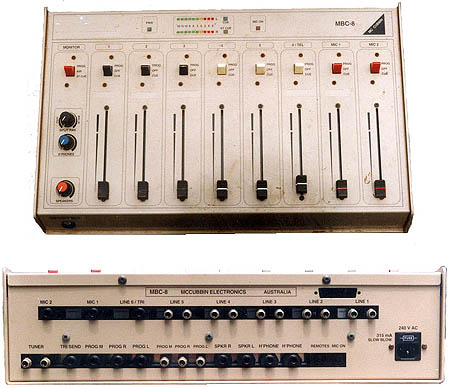
Mixer.
Photo: Evan Wyatt. Courtesy: TEABBA. |
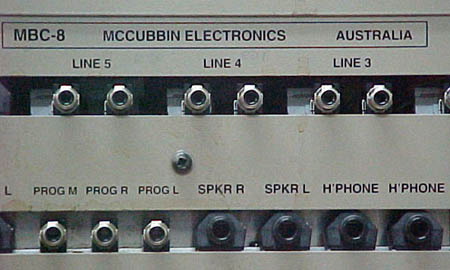
Rear
view of mixer close-up. Photo: Evan Wyatt. Courtesy:
TEABBA. |
Rostered
broadcasting
With twelve sites in the Top End having been upgraded
by TEABBA, they now have the capacity to contribute
regular program into the TEABBA satellite network.
All
stations work to a roster, Monday to Friday from 12
noon to 6pm, each station has two hours allocated for
broadcasting. The rostering system has to be very flexible,
as some broadcasters in communities have ceremony commitments
to attend to throughout the year, this can mean being
unavailable for weeks or even months at a time.
Maintenance
of the network
The ongoing maintenance of this equipment is an issue
being addressed by TEABBA. With 28 communities in the
Top End, a technician has been employed to coordinate
maintenance and installation work.
TEABBA
recognises the need for training of selected members
of the community to carry out simple fault diagnoses
on their equipment to assist in providing an efficient
maintenance service. TEABBA also plans to become a base
for training Aboriginal and Torres Strait Islander people
in the technical field.
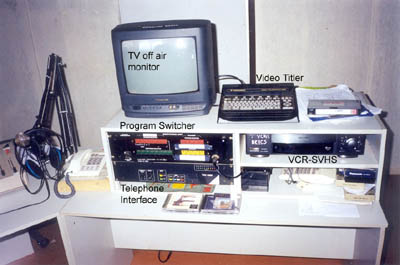 |
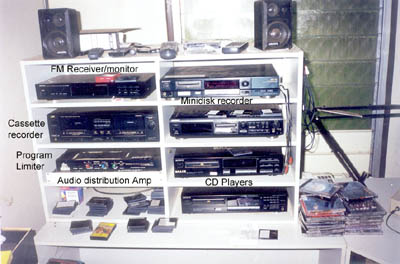 |
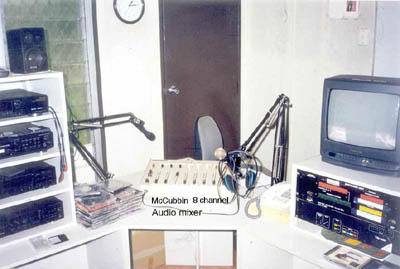
Typical console upgrade. Photo:
Evan Wyatt. Courtesy: TEABBA |
Nhulunbuy
region
This region has been the most active in their involvement
with the TEABBA network. The communities now on line
are Galiwinku, Gapuwiyak, Millingimbi, Ramingining,
Yirrkala, with two communities on Groote Eylandt, Umbakumba
and Angurugu to come online.
Broadcasters
in these communities have been long term operators and
the most experienced, contributing regular daily programs
into the TEABBA network.
One
of the most active communities is Gapuwiyak, who are
making much progress with both broadcasting and video
making, mainly due to the services of the resident anthropologist,
Jennifer Deger, who trains local operators in both radio
and video production. She is supported by funding from
the local council. In the 1996—97 year funds were
allocated for a language maintenance project.
Where
to from here?
The work does not stop here, there is a lot of upgrading
work that has to be completed with community studios,
that includes both buildings and equipment. There are
also a number of issues that need to be resolved with
TEABBA's operation:
- production
facilities need upgrading
- program
line quality needs improving
- a
need for ongoing training for broadcasters and technical
people.
- recognition
of the contribution to the National Indigenous Radio
Service (NIRS)
- national
recognition for the important work being done for
Aboriginal and Torres Strait Islander broadcasting
in Australia.
Studio
improvements
An eight track digital mixer/recorder for production
work has been purchased. This unit will be used in conjunction
with a digital audio tape (DAT) recorder for mastering
and archiving material. Minidisks are to be installed
in the production area, and to replace the aging cartridge
players in the main studio. Using minidisk in the studio
will enable production and distribution of material
for use on the community stations, as they are also
moving towards minidisk use. Two domestic machines have
been installed in communities on a test basis, they
have since proved to be popular with the broadcasters,
due to their ease of use.
Program
line quality
The quality of program lines from the communities needed
to be improved, especially now that program was being
fed into the NIRS and other broadcast stations around
the country.
Digital
technology, using the latest TieLine Codec boxes
have achieved this. A bandwidth of up to 10khz is now
possible over existing telephone circuits providing
a big improvement on the existing sound quality and
addressing the enormous costs confronting TEABBA to
provide permanent program lines from community stations.
In
early 1996, TEABBA secured funds from the National Indigenous
Media Association of Australia (NIMAA), to purchase
an ISDN Codec and a two port terminal adaptor to upgrade
the program link to IMPARJA, from a 10khz landline to
ISDN.
This
serves a dual purpose, it has allowed TEABBA to drop
the 10khz program line to Alice Springs and replace
it with a 64kb semi-permanent micro link, which has
resulted in line cost savings and has given more flexibility
with sourcing programs.
National
Indigenous Radio Service (NIRS)
The ISDN equipment has also given TEABBA the opportunity
to feed program into the NIRS - officially launched
in January 1996. The NIRS takes program feeds from Aboriginal
and Torres Strait Islander media associations from around
Australia, such as TEABBA, the program is routed through
an automation system, located in Brisbane, then fed
via an ISDN where it is uplinked to the OPTUS B3 satellite,
which has a footprint covering Australia.
A
new Internet-based service is planned too. It will provide
a national news service with coverage and content of
interest to Aboriginal and Torres Strait Islander people.
It will be known as the National Indigenous News Service
(NINS).
For
more information about the Optus satellites:
http://www.cwo.com.au/newsroom/1,1450,129,00.html
http://www.cwo.com.au/newsroom/1,1450,47,00.html
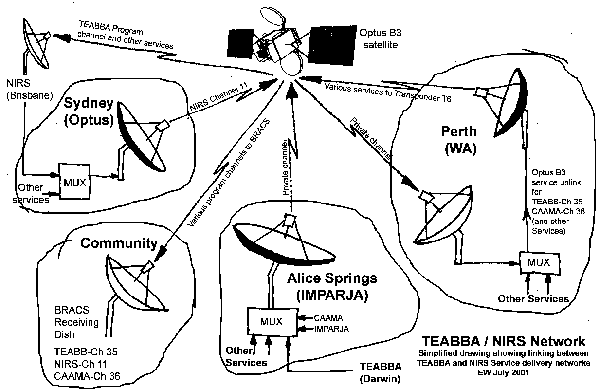
TEABBA/NIRS network. Courtesy: Evan
Wyatt. Courtesy: TEABBA.

Frank
Drirrimbilpilwuy, test transmission from TEABBA studio.
Courtesy: TEABBA. 1,851K
TEABBA network expansion
As the network gains support, TEABBA is encouraging
more community broadcasters to join the network and
be regular contributors of program. This is an important
process as it keeps the TEABBA organisation focused
on its charter and that is to encourage and promote
bush broadcasting.
The
role of the Darwin studio is to provide support and
backup for community broadcast stations, by providing
specialised programs of interest to communities, carry
out production work for distribution to the community
stations and be an administrative point for their broadcasters.
TEABBA
employs a marketer to sell sponsorship on the network
and a full time technician, employed mainly to service
the BRACS installations and carry out upgrade work.
|